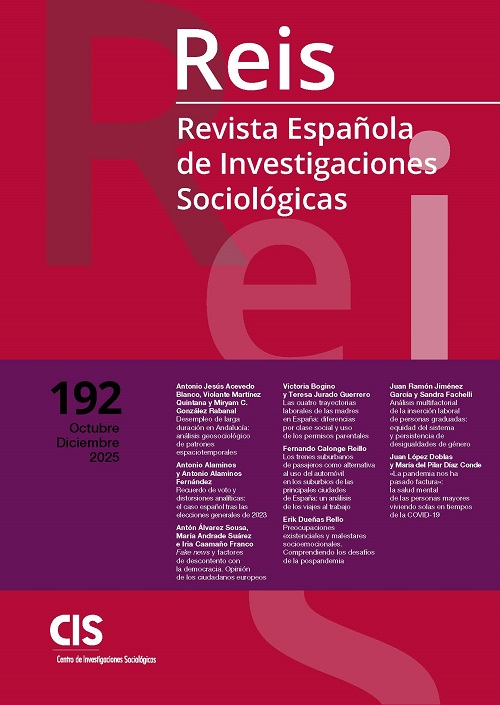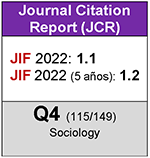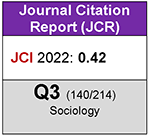Determinants of train use and transport disadvantage in Spanish non-central municipalities.
DOI:
https://doi.org/10.5477/cis/reis.192.87-104Keywords:
Transportations disadvantages, Train use, Car use, SuburbsAbstract
As global temperatures rise, the need to reduce car use for daily commutes becomes increasingly urgent. This study explores the potential of rail as a sustainable alternative, using data from the survey Essential Characteristics of the Population and Housing by the Spanish National Statistics Institute. While the study finds an increase in both train and car use in suburban areas, it also highlights that many of the factors influencing train choice are linked to transportation disadvantages. This raises concerns about the possibility of promoting new forms of social exclusion through sustainable transport policies.
Downloads
References
Aguilera, Anne y Mignot, Dominique (2004). «Urban Sprawl, Polycentrism and Commuting. A comparison of Seven French Urban Areas». Urban Public Economics Review, 1: 93-113.
Alonso, Andrea; Monzón, Andrés y Cascajo, Rocío (2015). «Comparative Analysis of passenger transport sustainability in European cities». Ecological Indicators, 48: 578-592. doi: 10.1016/j.ecolind.2014.09.022 DOI: https://doi.org/10.1016/j.ecolind.2014.09.022
American Public Transportation Association (2024). APTA Public Transportation Ridership Report. Washington: APTA.
Baum-Snow, Nathaniel (2010). «Changes in Transportation Infrastructure and Commuting Patterns in US Metropolitan Areas, 1960-2000». American Economic Review, 100: 378-382. DOI: https://doi.org/10.1257/aer.100.2.378
Brown, Jeffrey; Thompson, Gregory; Bhattacharya, Torscha y Jaroszynski, Michal (2014). «Understanding Transit Ridership Demand for the Multidestination, Multimodal Transit Network in Atlanta, Georgia: Lessons for Increasing Rail Transit Choice Ridership while Maintaining Transit Dependent Bus Ridership». Urban Studies, 51 (5): 938-958. doi: 10.1177/0042098013493021 DOI: https://doi.org/10.1177/0042098013493021
Brown, Barbara B.; Werner, Carol M.; Smith, Ken R.; Tribby, Calvin P.; Miller, Harvey J.; Jensen, Wyatt A. y Tharp, Doug (2016). «Environmental, behavioral, and psychological predictors of transit ridership: Evidence from a community intervention». Journal of Environmental Psychology, 46: 188-196. doi: 10.1016/j.jenvp.2016.04.010 DOI: https://doi.org/10.1016/j.jenvp.2016.04.010
Carpintero, Samuel; Maraña, V. y Barcham, R. (2010). «Benefits of Urban Light Trains: A Perspective from Spain». WIT Transactions on the Built Environment, 111: 239-248. doi: 10.2495/UT100221. DOI: https://doi.org/10.2495/UT100221
Casado-Díaz, José M; Simón-Albert, Raquel y Simón, Hipólito (2022). «Reassessing the commuting penalty for immigrants: new evidence from Spain». Transportation, 49: 1099-1132. doi: 10.1007/s11116-021-10204-5. DOI: https://doi.org/10.1007/s11116-021-10204-5
Cascajo, Rocío; Farber, Steven; Jordá, Pablo; Páez, Antonio y Monzón, Andrés (2010). «Urban form and bus ridership in Spanish cities». World Conference on Transport Research Society (WCTRS), Lisbon: 1-15.
Cervero, Robert (2006). «Office Development, Rail Transit, and Commuting Choices». Journal of Public Transportation, 9 (6): 41-55. doi: 10.5038/2375-0901.9.5.3 DOI: https://doi.org/10.5038/2375-0901.9.5.3
Cervero, Robert y Day, Jennifer (2008). «Suburbanization and transit-oriented development in China». Transport Policy, 15: 315-323. doi: 10.1016/j.tranpol.2008.12.011 DOI: https://doi.org/10.1016/j.tranpol.2008.12.011
Chang, Gang-Len; Lin, Tung-Ann y Lindley, Jeffery A. (2007). «Understanding suburban commuting characteristics: an empirical study in suburban Dallas». Transportation Planning and Technology, 16 (3): 167-193. doi: 10.1080/03081069208717482 DOI: https://doi.org/10.1080/03081069208717482
Chen, Tao; Ge, Yanbo y Pan, Haixiao (2021). «Car ownership and commuting mode of the “original” residents in a high-density city center: A case study in Shanghai». The Journal of Transport and Land Use, 14 (1): 105-124. doi: 10.5198/jtlu.2021.1606 DOI: https://doi.org/10.5198/jtlu.2021.1606
Combs, Tabitha S.; Shay, Elizabeth; Salvensen, David; Kolosna, Carl y Madeley, Michelle (2016). «Understanding the multiple dimensions of transportation disadvantage: the case of North Carolina». Case Studies on Transport Policy, 4 (2): 68-77. doi: 10.1016/j.cstp.2016.02.004 DOI: https://doi.org/10.1016/j.cstp.2016.02.004
Comisión Nacional de los Mercados y la Competencia (2023). Informe anual del sector ferroviario 2023. Barcelona: Comisión Nacional de los Mercados y la Competencia.
Currie, Graham y Delbosc, Alexa (2013). «Exploring Comparative Ridership Drivers of Bus Rapid Transit and Light Rail Transit Routes». Journal of Public Transportation, 16 (2): 47-65. doi: 10.5038/2375-0901.16.2.3 DOI: https://doi.org/10.5038/2375-0901.16.2.3
Delclós-Alió, Xavier y Miralles-Guasch, Carme (2017). «Suburban travelers pressed for time: Exploring the temporal implications of metropolitan commuting in Barcelona». Journal of Transport Geography, 65: 165-174. doi: 10.1016/j.jtrangeo.2017.10.016 DOI: https://doi.org/10.1016/j.jtrangeo.2017.10.016
Ekers, Michael; Hamel, Pierre y Keil, Roger (2012). «Governing Suburbia: Modalities and Mechanisms of Suburban Governance». Regional Studies, 46(3): 405-422. doi: 10.1080/00343404.2012.658036 DOI: https://doi.org/10.1080/00343404.2012.658036
Freudendal-Pedersen, Malene (2009). Mobility in Daily Life: Between Freedom and Unfreedom. Farnham: Aldershot.
Gao, Qi-Li; Li, Qing-Quan; Zhuang, Yan; Yue, Yang; Liu, Zhen-Zhen; Li, Shui-Quan y Sui, Daniel (2019). «Urban commuting dynamics in response to public transit upgrades: A big data approach». Plos One, 14 (10): e0223650. doi: 10.1371/journal.pone.0223650 DOI: https://doi.org/10.1371/journal.pone.0223650
Gately, Conor K.; Hutyra, Lucy A. y Wing, Ian Sue (2015). «Cities, traffic and CO2: A multidecadal assessment of trends, drivers, and scaling relationships». Proceedings of the National Academy of Sciences, 112 (16): 4999-5004. DOI: https://doi.org/10.1073/pnas.1421723112
Guerra, Erick (2014). «The Built Environment and Car Use in Mexico City: Is the Relationship Changing over Time?». Journal of Planning Education and Research, 34 (4): 394-408. doi: 10.1177/0739456X14545170 DOI: https://doi.org/10.1177/0739456X14545170
Habib, Khandker Nurul (2014). «Household-level commuting mode choices, car allocation and car ownership level choices of two-worker households: the case of the city of Toronto». Transportation, 41: 651-672. doi: 10.1007/s11116-014-9518-5 DOI: https://doi.org/10.1007/s11116-014-9518-5
Hine, Julian (2011). Mobility and Transport Disadvantage. En: M. Grieco y J. Urry (eds.). Mobilities: new perspectives on transport and society. London: Routledge.
Hull, Angela (2011). Transport Matters: Integrated Approaches to Planning City-Regions. London: Routledge.
Intergovernmental Panel on Climate Change (2023). Climate Change 2023. Synthesis Report. Geneva.
International Association of Public Transport (2024). Urban Rail Transport. Definition by the Urban Rail Platform. Brussels: UITP Europe/UNIFE
Jacques, Cynthia; Manaugh, Kevin y El-Geneidy, Ahmed (2012). «Rescuing the captive (mode) user: an alternative approach to transport market segmentation». Transportation, 40: 625-645. doi: 10.1007/s11116-012-9437-2 DOI: https://doi.org/10.1007/s11116-012-9437-2
Kamruzzaman, Md.; Yigitcanlar, Tan; Yang, Jay y Mohamed, Mohd Afzan (2016). «Measures of Transport-Related Social Exclusion: A Critical Review of the Literature». Sustainability 8 (7): 696. doi: 10.3390/su8070696 DOI: https://doi.org/10.3390/su8070696
Khan, Shakil; Maoh, Hanna; Lee, Chris y Anderson, William (2016). «Toward sustainable urban mobility: Investigating nonwork travel behavior in a sprawled Canadian city» International Journal of Sustainable Transportation, 10 (4): 321-331. doi: 10.1080/15568318.2014.928838 DOI: https://doi.org/10.1080/15568318.2014.928838
King, Gary y Zeng, Langche (2001). «Logistic Regression in Rare Events Data». Political Analysis, 9 (2): 137-163. doi: 10.1093/oxfordjournals.pan.a004868 DOI: https://doi.org/10.1093/oxfordjournals.pan.a004868
Litman, Todd (2005). London Congestion Pricing -Implications for Other Cities. Victoria: Victoria Transport Policy Institute.
Liu, Shasha; Yao, Enjian y Li, Binbin (2018). «Exploring urban rail transit station-level ridership growth with network expansion». Transportation Research Part D, 73: 391-402. doi: 10.1016/j.trd.2018.04.006 DOI: https://doi.org/10.1016/j.trd.2018.04.006
Loo, Becky P. Y.; Chen, Cynthia y Chan, Eric T.H. (2010). «Rail-based transit-oriented development: Lessons from New York City and Hong Kong». Landscape and Urban Planning, 97: 202-212. doi: 10.1016/j.landurbplan.2010.06.002 DOI: https://doi.org/10.1016/j.landurbplan.2010.06.002
Luo, Zicong; Xiong, Yubing y Xiong, Zechen (2019). «Effects of Built Environment on People’s Travel Behavior in Nanchang, China». The 5th International Conference on Transportation Information and Safety. DOI: https://doi.org/10.1109/ICTIS.2019.8883838
Manaugh, Kevin y El-Geneidy, Ahmed M. (2010) «Who benefits from new transportation infrastructure? Evaluating social equity in transit provision in Montreal». 57th Annual North American Meeting of the Regional Science Association.
Marmolejo Duarte, Carlos y Tornés Fernández, Moira (2017). «The influence of urban structure on commuting: an analysis for the main metropolitan systems in Spain». Procedia Engineering, 198: 52-68. doi: 10.1016/j.proeng.2017.07.073 DOI: https://doi.org/10.1016/j.proeng.2017.07.073
Matas, Anna; Raymond, José-Luis y Roig, José-Luis (2009). «Car ownership and access to jobs in Spain». Transportation Research Part A, 43 (6): 607-617. doi:10.1016/j.tra.2009.04.003 DOI: https://doi.org/10.1016/j.tra.2009.04.003
Moavenzadeh, F. y Markow, M. J. (2007). Moving Millions: Transport Strategies for Sustainable Development in Megacities. Dordrecht: Springer. DOI: https://doi.org/10.1007/978-1-4020-6702-0
Módenes-Cabrerizo, Juan Antonio y Menacho-Montes, Teresa (2019). «Diversidad Regional en España del Uso del Coche para Ir a Trabajar: ¿Diferencias de Comportamiento o de Composición?». Revista de Estudios Andaluces, 37: 71-93. doi: 10.12795/rea.2019.i37.04 DOI: https://doi.org/10.12795/rea.2019.i37.04
Mohan, Dinesh (2008). «Mythologies, Metro Rail Systems and Future Urban Transport». Economic y Political Weekly, 43(4): 41-53. doi: 10.2307/40277079.
Muñoz Miguel, Juan Pedro; Simón de Blas, Clara y Jiménez Barandalla, Iciar Carmen (2014). «Estudio empírico sobre la utilización del transporte público en la Comunidad de Madrid como factor clave de la movilidad sostenible». Cuadernos de Economía, 37: 112-124. doi: 10.1016/j.cesjef.2013.12.001. DOI: https://doi.org/10.1016/j.cesjef.2013.12.001
Muñoz Rubio, Miguel (2016). Renfe, 75 años de historia (1941-2016). Madrid: Fundación de los Ferrocarriles Españoles.
Nasri, Arefeh y Zhang, Lei (2019). «Multi-level urban form and commuting mode share in rail station areas across the United States; a seemingly unrelated regression approach». Transport Policy, 81: 311-319. doi: 10.1016/j.tranpol.2018.05.011 DOI: https://doi.org/10.1016/j.tranpol.2018.05.011
National Aeronautics and Space Administration (2024). Global temperature 2023. Disponible en: https://climate.nasa.gov/vital-signs/global-temperature/?intent=121, acceso 7 de septiembre 2024.
Newman, Peter (2009). Planning for Transit Oriented Development: Strategic Principles. En: C. Curtis; J. L. Renne y L. Bertolini (eds.). Transit Oriented Development: Making it Happen. Farnham: Ashgate
Obry-Legos, Vincent y Boisjoly, Genevieve (2024). «Will you ride the train? A combined home-work spatial segmentation approach». Journal of Transport and Land Use, 17 (1): 67-96. doi: 10.5198/jtlu.2024.2278 DOI: https://doi.org/10.5198/jtlu.2024.2278
Observatorio de la Movilidad Metropolitana (2024). Informe OMM 2022- Avance 2023. Madrid: Ministerio de Transportes y Movilidad Sostenible.
Observatorio del Transporte y la Logística en España (2020). Movilidad Urbana y Metropolitana: Un gran reto de las ciudades del siglo XXI. Madrid: Ministerio de Transportes, Movilidad y Agenda Urbana.
Oña, Juan de; Calvo, Francisco J.; Garach, Laura; Oña, Rocío de y López, Griselda (2010). «How to Expand Subway and Urban Railway Networks: Light Rail Extensions in Madrid, Spain». Transportation Research Record, 2146: 10-17. doi:10.3141/2146-02 DOI: https://doi.org/10.3141/2146-02
Oña, Juan de; Estévez, Esperanza y Oña, Rocío de (2020). «Perceptions of Public Transport Quality of Service among Regular Private Vehicle Users in Madrid, Spain». Transportation Research Record, 2674 (2): 213-224. doi: 10.1177/0361198120907095 DOI: https://doi.org/10.1177/0361198120907095
Oña, Juan de; Estévez, Esperanza y Oña, Rocío de (2021). «Public transport users versus private vehicle users: Differences about quality of service, satisfaction and attitudes toward public transport in Madrid (Spain)». Travel Behaviour and Society, 23: 76-85. doi: 10.1016/j.tbs.2020.11.003 DOI: https://doi.org/10.1016/j.tbs.2020.11.003
Oña, Juan de y Oña, Rocío de (2022). «Is it possible to attract private vehicle users towards public transport? Understanding the key role of service quality, satisfaction and involvement on behavioral intentions». Transportation, 50: 1073-1101. doi: 10.1007/s11116-022-10272-1 DOI: https://doi.org/10.1007/s11116-022-10272-1
Pan, Haixiao; Li, Jing; Shen, Qing y Shi, Cheng (2017). «What determines rail transit passenger volume? Implications for transit oriented development planning». Transportation Research Part D, 57: 52-63. doi: 10.1016/j.trd.2017.09.016 DOI: https://doi.org/10.1016/j.trd.2017.09.016
Peng, Chao-Ying Joanne; Lee, Kuk Lida y Ingersoll, Gary M. (2002). «An Introduction to Logistic Regression Analysis and Reporting». The Journal of Educational Research, 96(1): 3-14. doi: 10.1080/00220670209598786 DOI: https://doi.org/10.1080/00220670209598786
Pinjari, Abdul Rawoof; Pendyala, Ram M.; Bhat, Chandra R. y Wadell, Paul A. (2011). «Modeling the choice continuum: an integrated model of residential location, auto ownership, bicycle ownership, and commute tour mode choice decisions». Transportation, 38: 933-958. doi: 10.1007/s11116-011-9360-y DOI: https://doi.org/10.1007/s11116-011-9360-y
Pitarch Garrido, María Dolores (2013). «Measuring Equity and social sustainability through accessibility to public services by public transport: the case of the Metropolitan area of Valencia (Spain)». European Journal of Geography 4(1): 46-85.
Puhe, Maike y Schippl, Jens (2015). «User Perceptions and Attitudes on Sustainable Urban Transport among Young Adults: Findings from Copenhagen, Budapest and Karlsruhe». Journal of Environmental Policy y Planning, 16(3): 337-357. doi: 10.1080/1523908X.2014.886503 DOI: https://doi.org/10.1080/1523908X.2014.886503
Senior, Martyn L. (2009). «Impacts on travel behaviour of Greater Manchester’s light rail investment (Metrolink Phase 1): evidence from household surveys and Census data». Journal of Transport Geography, 17: 187-197. doi: 10.1016/j.jtrangeo.2008.11.004 DOI: https://doi.org/10.1016/j.jtrangeo.2008.11.004
Shay, Elizabeth; Combs, Tabitha S.; Findley, Daniel; Kolosna, Carl; Madeley, Michelle y Salvesen, David (2016). «Identifying transport disadvantage: Mixed-methods analysis combining GIS mapping with qualitative data». Transport Policy, 49: 129-138. doi: 10.1016/j.tranpol.2016.03.002 DOI: https://doi.org/10.1016/j.tranpol.2016.03.002
Shung, Hyungun; Choi, Keecho; Lee, Sugie y Cheon, SangHyun (2014). «Exploring the impacts of land use by service coverage and station-level accessibility on rail transit ridership». Journal of Transport Geography, 36: 134-140. doi: 10.1016/j.jtrangeo.2014.03.013 DOI: https://doi.org/10.1016/j.jtrangeo.2014.03.013
Sun, Zhe y Zacharias, John (2022). «Do housing tenure and public transport provision matter in automobile use in bedroom suburban communities? Evidence from Beijing». Journal of Housing and the Built Environment, 36: 241-262. doi: 10.1007/s10901-020-09748-2. DOI: https://doi.org/10.1007/s10901-020-09748-2
Surprenant-Legault, Julien; Patterson, Zachary y El-Geneidy, Ahmed M. (2013). «Commuting trade-offs and distance reduction in two-workers households». Transportation Research Part A, 51: 12-28. doi: 10.1016/j.tra.2013.03.003 DOI: https://doi.org/10.1016/j.tra.2013.03.003
Tammaru, Tiit (2005). «Suburbanisation, employment change, and commuting in the Tallinn metropolitan area». Environment and Planning A, 37: 1669-1687. doi: 1068/a37118 DOI: https://doi.org/10.1068/a37118
Topalovic, Peter; Tobey, Danielle y Lotimer, Leslea (2008). Community Impact & Economic Analylsis of Light Rail Transit. Hamilton: Rapid Transit Office.
Wachs, Martin (2013). «Turning cities inside out: transportation and the resurgence of downtowns in North America». Transportation, 40: 1159-1172. doi: 10.1007/s11116-013-9501-6 DOI: https://doi.org/10.1007/s11116-013-9501-6
Woldeamanuel, Mintesnot; Cyganski, Rita; Schulz, Angela y Justen, Andreas (2009). «Variations of households’ car ownership across time: application of a panel data model». Transportation, 36: 371-387. doi: 10.1007/s11116-009-9210-3. DOI: https://doi.org/10.1007/s11116-009-9210-3
Wolny, Ada (2019). «Are suburban commuters confined to private transport? A case study of a medium-sized functional urban area (FUA) in Poland». Cities, 92: 82-96. doi: 10.1016/j.cities.2019.03.013 DOI: https://doi.org/10.1016/j.cities.2019.03.013
Yan, Ran y Yang, Bo (2023). «Interactive effects of the built environment and rail transit on commuting behavior: Evidence from Hefei, China». Heliyon, 9: e2178. doi: 10.1016/j.heliyon.2023.e21788 DOI: https://doi.org/10.1016/j.heliyon.2023.e21788
Downloads
Published
How to Cite
Issue
Section
License
Copyright (c) 2024 Revista Española de Investigaciones Sociológicas

This work is licensed under a Creative Commons Attribution-ShareAlike 4.0 International License.
Permite Compartir — copiar y redistribuir el material en cualquier medio o formato, Adaptar — remezclar, transformar y construir a partir del material para cualquier propósito, incluso comercialmente.








